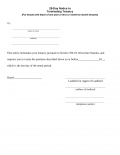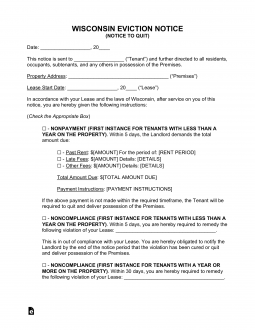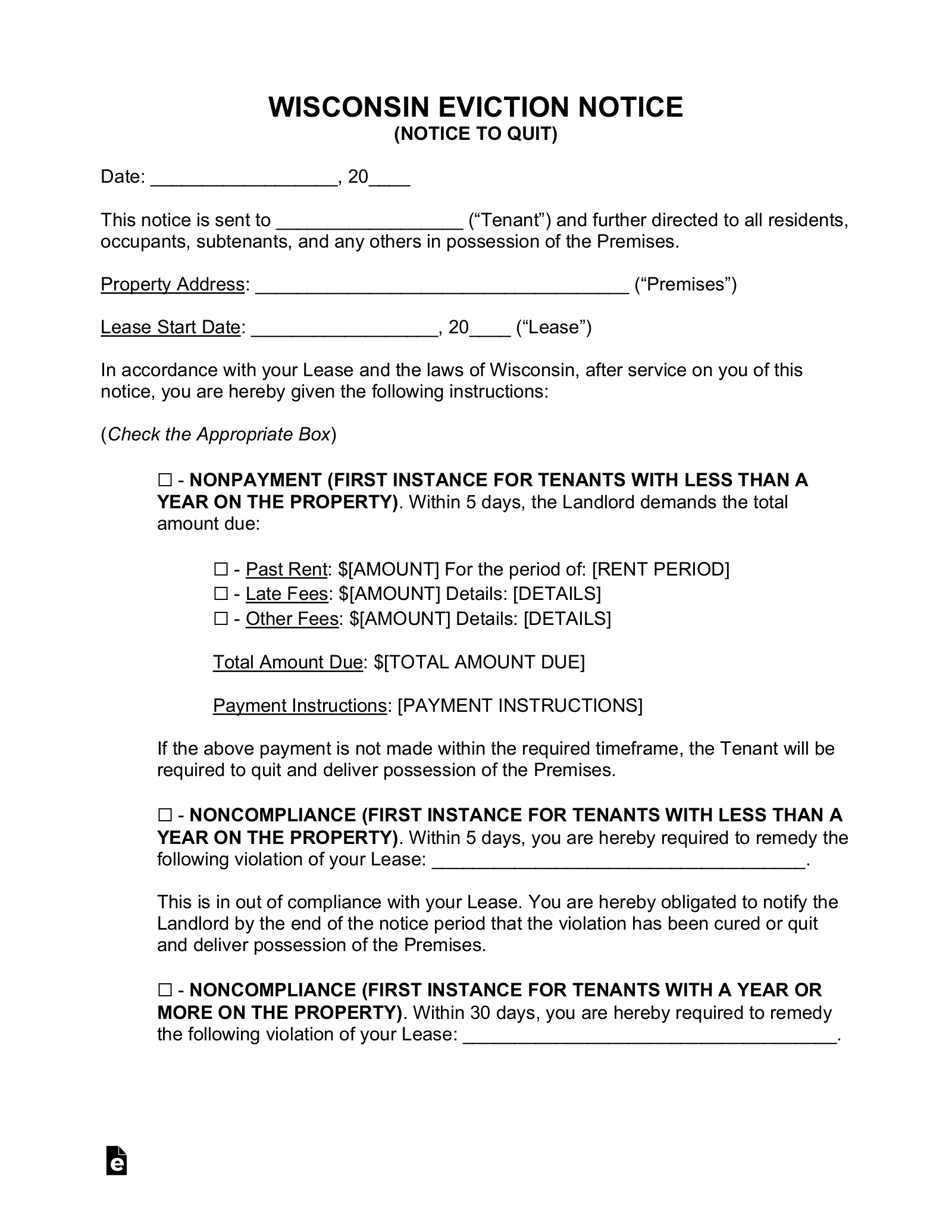Updated April 12, 2024
A Wisconsin eviction notice is a form a landlord gives a tenant who has failed to follow the terms and conditions of a lease. The notice can either give the tenant a period of time to correct the issue or state that their rental contract has been terminated on specific grounds by the landlord.
By Type (4)
 5-Day Notice to Quit (1st Violation for Leases of a Year or Less) – First violation for lease terms of a year or less. This is for nonpayment, noncompliance, or an unlawful activity violation. 5-Day Notice to Quit (1st Violation for Leases of a Year or Less) – First violation for lease terms of a year or less. This is for nonpayment, noncompliance, or an unlawful activity violation.
Download: PDF, MS Word, OpenDocument |
 14-Day Notice to Quit (2nd Lease Violation) – Second notice for any type of lease violation. May only be served to the tenant when there have been two separate violations within a 12-month period. Only served when the rental agreement is to be terminated. The tenant must move out at the end of 14 days. 14-Day Notice to Quit (2nd Lease Violation) – Second notice for any type of lease violation. May only be served to the tenant when there have been two separate violations within a 12-month period. Only served when the rental agreement is to be terminated. The tenant must move out at the end of 14 days.
Download: PDF, MS Word, OpenDocument |
 28-Day Notice to Quit (Month-to-Month Tenancy) – Used when parties seek to end a month-to-month tenancy and have to provide notice of 28 days to the other party. 28-Day Notice to Quit (Month-to-Month Tenancy) – Used when parties seek to end a month-to-month tenancy and have to provide notice of 28 days to the other party.
Download: PDF, MS Word, OpenDocument |
 30-Day Notice to Quit (1st Violation for Leases for More than a Year) – First violation of a lease with a term of a year or more. 30-Day Notice to Quit (1st Violation for Leases for More than a Year) – First violation of a lease with a term of a year or more.
Download: PDF |
Table of Contents |
Eviction Laws
- Rent Grace Period: No grace period unless explicitly permitted in the rental agreement.[1]
- Non-Payment of Rent: 5 days for the first violation with the option to remedy, 14 days for the second violation without the option to remedy.[2]
- Non-Compliance: 5 days for the first violation with the option to remedy, 14 days for the second violation without the option to remedy.[3]
- Termination (Month-to-Month Lease): 28 days.[4]
- Eviction Lawsuit: Eviction Actions.[5]
Court Forms
Summons and Complaint (SC-500i) – Completed by the landlord and filed with the small claims court when pursuing a court order for the eviction of a tenant. A copy will be served on the tenant to inform them of the upcoming eviction hearing.
Declaration of Nonmilitary Service (GF-175) – Filed by the landlord, alongside the eviction complaint, to affirm whether a tenant is or is not on active military duty.
Answer and Counterclaim (SC-5200V) – Tenants served with eviction paperwork may respond to the allegations by filing this document with the court. A copy must also be delivered to the landlord.
Affidavit of Service (SC-5100V) – A form used to affirm the proper service of a Summons and Complaint upon a tenant.
Writ of Restitution (SC-512) – Issued by the court after an eviction lawsuit has been settled in favor of the landlord. This form authorizes the sheriff to remove the tenant from the premises using force if necessary.
How to Evict a Tenant (4 steps)

1. Provide Notice to Tenant
The first step to evicting a tenant is to provide requisite notice that the tenant is violating the terms of the lease, either through non-payment of rent or for some other violation. The notice must be properly served with evidence of the service, such as an affidavit or certified mail receipt. There are several forms of notice in Wisconsin depending on the circumstances:
2. File Summons and Complaint
If the tenant does not respond either by vacating the premises or by rectifying the situation (if that is an option), the landlord may proceed to the Small Claims Court in the county in which the property is located and file a Summons and Complaint. The landlord must also complete a Non-Military Service Affidavit and Affidavit of Service of Notice.
The filing fee varies by county.
3. Serve Tenant
The landlord must deliver the packet to a process server to serve the tenant. The tenant must be served at least five days before the court date and has the right to defend themselves by filing the Answer and Counterclaim.
4. Receive Court Order
If the landlord prevails, the court will issue an order for a Writ of Restitution. The landlord will bring this order to the sheriff, along with a set of keys to the property and a letter of authority from a mover. The sheriff will have 10 days from receiving the order to evict the tenant.


